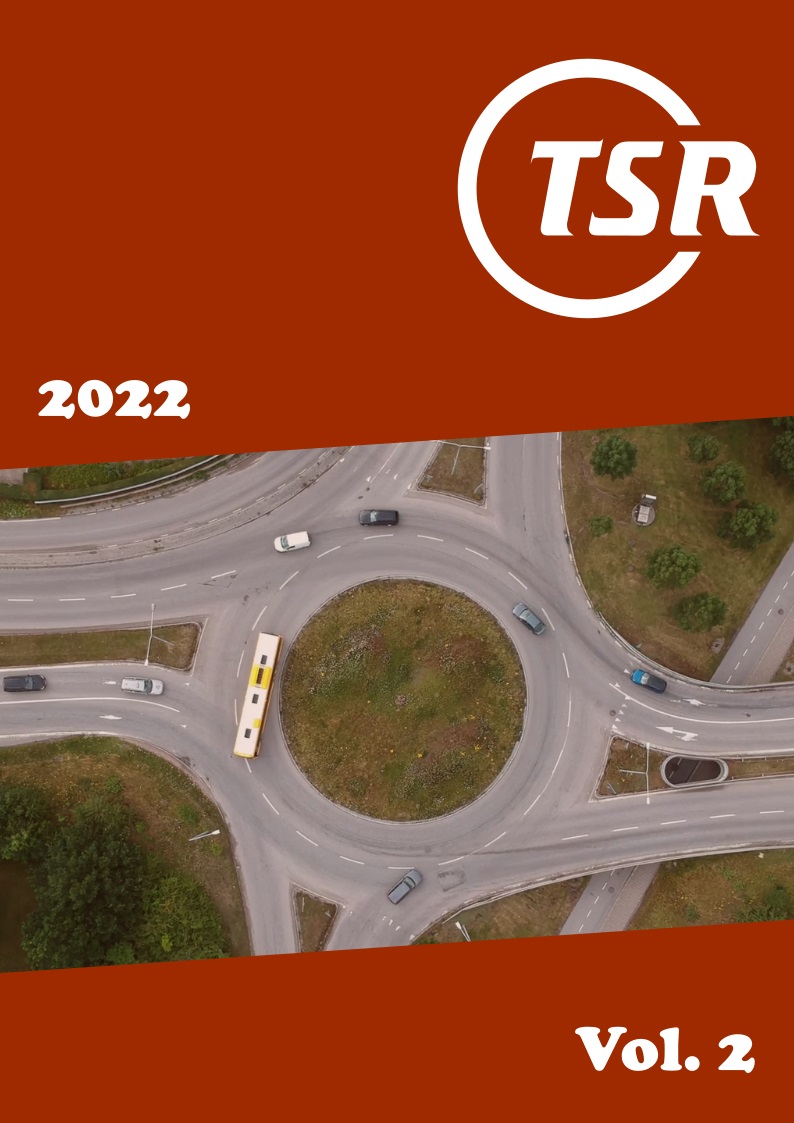Searching for relationships between self-reported familiarity and road safety based on surveys with geographic variability
DOI:
https://doi.org/10.55329/btdw5686Keywords:
driver behavior, familiarity, international study, road safety, surveyAbstract
The study is aimed at understanding if (a) declared driving behavioural changes due to familiarity can be observed through surveys; (b) self-reported route familiarity can be related to negative safety performances (crashes and fines); (c) the relationships are stable across different countries. Driving on habitual routes could imply different behaviours than on generic routes, and possibly different safety performances. The relationships between route familiarity and safety performances are often searched through experimental studies or accident data analyses. Surveys were spread to young Italian and Norwegian drivers, asking both general and specific questions on the habitual route travelled and the recently experienced crashes and fines. 316 answers, 235 Italian and 71 Norwegian, were analysed. Comparisons of self-reported driving scores between generic and habitual routes were performed. Logistic regressions having as response variables negative outcomes (crashes and fines) on frequent routes, different behaviour on habitual routes, and nationality were developed. Different relationships were highlighted, concerning differences in perceived ability on the habitual route, a possible excess of self-confidence, which however are differently related to crashes and fines. Different tendencies were found for the same variables in the two countries, sometimes opposite. Surveys are suggested as useful to reveal familiarity-behavioural changes/negative outcomes relationships. Considering international studies may reveal significant driving behavioural differences and patterns. The results have some potential applications for driver education, since some relationships between familiarity effects in young drivers and negative safety outcomes were noted.
Downloads
References
Blatt, J., S. M. Furman (1998), ‘Residence location of drivers involved in fatal crashes’, Accident Analysis & Prevention, 30 (6), 705–711, https://doi.org/10.1016/s0001-4575(98)00014-1.
Burdett, B. R. D., S. G. Charlton, N. J. Starkey (2016), ‘Not all minds wander equally: The influence of traits, states and road environment factors on self-reported mind wandering during everyday driving’, Accident Analysis & Prevention, 95, 1–7, https://doi.org/10.1016/j.aap.2016.06.012.
Charlton, S. G., N. J. Starkey (2013), ‘Driving on familiar roads: Automaticity and inattention blindness’, Transportation Research Part F: Traffic Psychology and Behaviour, 19, 121–133, https://doi.org/10.1016/j.trf.2013.03.008.
Colonna, P., P. Intini, N. Berloco, V. Ranieri (2016), ‘The influence of memory on driving behavior: How route familiarity is related to speed choice. An on-road study’, Safety Science, 82, 456–468, https://doi.org/10.1016/j.ssci.2015.10.012.
Davey, J., D. Wishart, J. Freeman, B. Watson (2007), ‘An application of the driver behaviour questionnaire in an Australian organisational fleet setting’, Transportation Research Part F: Traffic Psychology and Behaviour, 10 (1), 11–21, https://doi.org/10.1016/j.trf.2006.03.001.
DeJoy, D. M. (1989), ‘The optimism bias and traffic accident risk perception’, Accident Analysis & Prevention, 21 (4), 333–340, https://doi.org/10.1016/0001-4575(89)90024-9.
González-Iglesias, B., J. A. Gómez-Fraguela, M. Á. Luengo-Martín (2012), ‘Driving anger and traffic violations: Gender differences’, Transportation Research Part F: Traffic Psychology and Behaviour, 15 (4), 404–412, https://doi.org/10.1016/j.trf.2012.03.002.
Harms, I. M., B. R. D. Burdett, S. G. Charlton (2021), ‘The role of route familiarity in traffic participants’ behaviour and transport psychology research: A systematic review’, Transportation Research Interdisciplinary Perspectives, 9, 100331, https://doi.org/10.1016/j.trip.2021.100331.
Hjorthol, R., Ø. Engebretsen, T. P. Uteng (2014 ), ‘Den nasjonale reisevaneundersøkelsen 2013/14: nøkkelrapport ’ [The national travel habits survey 2013/14-key report] (Oslo, Norway: Institute of Transport Economics), https://www.toi.no/getfile.php?mmfileid=39511, accessed 26 November 2022.
Høye, A. K., I. S. Hesjevoll (2020), ‘Traffic volume and crashes and how crash and road characteristics affect their relationship – A meta-analysis’, Accident Analysis & Prevention, 145, 105668, https://doi.org/10.1016/j.aap.2020.105668.
Intini, P., N. Berloco, P. Colonna, et al. (2018), ‘Exploring the relationships between drivers’ familiarity and two-lane rural road accidents. A multi-level study’, Accident Analysis & Prevention, 111, 280–296, https://doi.org/10.1016/j.aap.2017.11.013.
Intini, P., N. Berloco, P. Colonna, et al. (2019a), ‘Influence of Road Geometric Design Consistency on Familiar and Unfamiliar Drivers’ Performances: Crash-Based Analysis’, Transportation Research Record: Journal of the Transportation Research Board, 2673 (10), 489–500, https://doi.org/10.1177/0361198119851446.
Intini, P., P. Colonna, E. Olaussen Ryeng (2019b), ‘Route familiarity in road safety: A literature review and an identification proposal’, Transportation Research Part F: Traffic Psychology and Behaviour, 62, 651–671, https://doi.org/10.1016/j.trf.2018.12.020.
Intini, P., N. Berloco, P. Colonna, et al. (2020), ‘Self-Reported Route Familiarity and Road Safety Negative Outcomes: First Results from a Transnational Survey-Based Study’, Transportation Research Procedia, 45, 46–53, https://doi.org/10.1016/j.trpro.2020.02.061.
Liu, C., T. J. Ye (2011), ‘Run-off-road crashes: An on-scene perspective’ (Washington, DC, USA: National Center for Statistics and Analysis), DOT HS 811 500, https://crashstats.nhtsa.dot.gov/Api/Public/ViewPublication/811500, accessed 26 November 2022.
Manley, E., T. Cheng, A. Penn, A. Emmonds (2014), ‘A framework for simulating large-scale complex urban traffic dynamics through hybrid agent-based modelling’, Computers, Environment and Urban Systems, 44, 27–36, https://doi.org/10.1016/j.compenvurbsys.2013.11.003.
Martens, M. H., M. R. J. Fox (2007), ‘Do familiarity and expectations change perception? Drivers’ glances and response to changes’, Transportation Research Part F: Traffic Psychology and Behaviour, 10 (6), 476–492, https://doi.org/10.1016/j.trf.2007.05.003.
Massie, D. L., K. L. Campbell, A. F. Williams (1995), ‘Traffic Accident involvement rates by driver age and gender’, Accident Analysis & Prevention, 27 (1), 73–87, https://doi.org/10.1016/0001-4575(94)00050-v.
Nordfjærn, T., Ö. Şimşekoğlu, T. Rundmo (2014), ‘Culture related to road traffic safety: A comparison of eight countries using two conceptualizations of culture’, Accident Analysis & Prevention, 62, 319–328, https://doi.org/10.1016/j.aap.2013.10.018.
Reason, J. (1990), Human Error (Cambridge: Cambridge University Press), https://doi.org/10.1017/cbo9781139062367.
Rosenbloom, T., A. Perlman, A. Shahar (2007), ‘Women drivers' behavior in well-known versus less familiar locations’, Journal of Safety Research, 38 (3), 283–288, https://doi.org/10.1016/j.jsr.2006.10.008.
Sánchez, M. I. O., E. M. González (2016), ‘Gender Differences in Commuting Behavior: Women's Greater Sensitivity’, Transportation Research Procedia, 18, 66–72, https://doi.org/10.1016/j.trpro.2016.12.009.
Van den Berghe, W., M. Schachner, V. Sgarra, N. Christie (2020), ‘The association between national culture, road safety performance and support for policy measures’, IATSS Research, 44 (3), 197–211, https://doi.org/10.1016/j.iatssr.2020.09.002.
Venables, W. N., B. D. Ripley (2002), Modern Applied Statistics with S (New York: Springer), https://doi.org/10.1007/978-0-387-21706-2.
WHO (2018), ‘Global status report on road safety 2018’ (Geneva, Switzerland: World Health Organization), https://www.who.int/publications/i/item/9789241565684, accessed 26 November 2022.
de Winter, J. C. F., D. Dodou (2010), ‘The Driver Behaviour Questionnaire as a predictor of accidents: A meta-analysis’, Journal of Safety Research, 41 (6), 463–470, https://doi.org/10.1016/j.jsr.2010.10.007.
Wu, J., H. Xu (2018), ‘The influence of road familiarity on distracted driving activities and driving operation using naturalistic driving study data’, Transportation Research Part F: Traffic Psychology and Behaviour, 52, 75–85, https://doi.org/10.1016/j.trf.2017.11.018.
Yanko, M. R., T. M. Spalek (2013), ‘Route familiarity breeds inattention: A driving simulator study’, Accident Analysis & Prevention, 57, 80–86, https://doi.org/10.1016/j.aap.2013.04.003.
Yannis, G., J. Golias, E. Papadimitriou (2007), ‘Accident risk of foreign drivers in various road environments’, Journal of Safety Research, 38 (4), 471–480, https://doi.org/10.1016/j.jsr.2007.01.014.
Downloads
Published
How to Cite
Issue
Section
License
Copyright (c) 2022 Paolo Intini, Nicola Berloco, Pasquale Colonna, Damiano De Gennaro, Vittorio Ranieri, Eirin Olaussen Ryeng

This work is licensed under a Creative Commons Attribution 4.0 International License.













